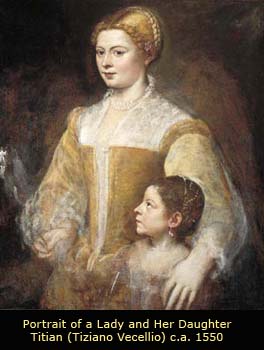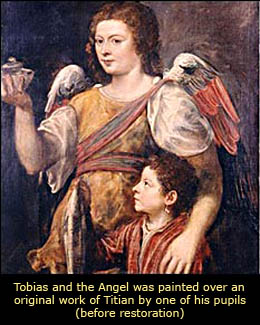Portrait of a Lady and her Daughter (Emilia)
Italian Renaissance
Titian (Tiziano Vecellio),
1550-60
The history of this painting is extraordinary and its survival a miracle. Since its creation in about 1550, the life of the painting has been very exciting. The Titian's, unique double portrait depicts a mother and a daughter whose subjects remain an fascinating mystery. Some scholars and art critics suggest that the sitters are Titian's daughter Emila with one of his granddaughters. The rediscovered picture caused much confusion in artistic world. Its unfinished state provides a fascinating glimpse ins a Titian's working methods and technique. It also offering the chance to further examine the later style of his painting. More over, the composition of this charming scene which depicts a young woman putting an arm around a child is unique for Titian works. Titian, appointed as the official painter to the Venetian Republic (1516 - 1550), was the leading portrait painter of the XVI century. His portraits were flattering and sympathetic. He had remarkable abilities to please his sitters, yet retain an artistic integrity and insight into individual soul. He established compelling model for aristocratic portraiture, which remains influential for centuries. His portraits stand at the head of a portraiture, championed by such artists as Rubens, van Dyck, Reynolds and Sargent.
Like many portrait painters he concentrating on the heads, quickly capturing the likeness of his sitters. As a result, both heads and the faces of a mother and a child are carefully worked to the last smallest detail, but the lady's arm and hand, in particular, are sketchily done. Emilia is shown as at a moment when her mature beauty is splendid and maternal. Her appearance is fashionable. Her thick blond hair is curled back in a torciglione (an eel-shaped motive) across her forehead. Her magnificent, silk dress is elaborate and ample. Her daughter s brown hair is adorned with pearls. She has an earring probably made of amethyst. Emilia's beautiful eyes are looking directly at the viewer while her daughter is looking at the feather in the hand of her mother.
Titian died in 1576 from the plague leaving the painting unfinished. The work was painted over after Titian's death probably by one of his pupils to portray the Biblical story of the angel Raphael who accompanied Tobias on a journey to recover money for his father, presumably for commercial reasons. The two faces remaining largely intact, but the Lady was given wings and became the Archangel Raphael, while her daughter was given a male hairstyle to became Tobias. The primary intention may have been to sell it to the church but for unknown reason the painting remained after his death in Titian's house. In 1581 good friend of Titian, Cristoforo Barbarigo, had bought his house and studio including all its contents and other unfinished works. The Tobias and the Angel remained in Barbarigo's collection till 1850, when Barbarigo collection was sold to Tsar Nicolas I of Russia. However, a few years later the Tsar was convinced by his art experts to sell part of his collection. The Tobias and the Angel was purchased buy Polish-Russian aristocrat Count Tyszkiewicz. By the 1920 the painting was a property of French art dealer, Rene Gimpel. At the outbreak of World War II, to avoid confiscation by Germans, Rene Gimpel sent all his collection of paintings to hiding place in London. He joined and fought in the French Resistance against German occupation. He was captured and sent to the slave-labour camp at Neuengamme and perished in 1944. Before his death he did not reveal the location of his collection. He took the secret with him. In 1946 the Titian along many others was discovered by his son Ernest. The collection of paintings of his father was hidden in a garage in Bayswater, London, which had been damaged by German bombs during the Blitz. In 1948 narrowly escaped destruction Titian' Tobias and the Angel has been X-rayed by Stephen Rees-Jones at the Courtauld Institute Technology Department. During the examination the underlaying composition became apparent for the first time. The picture of the master called now Lady and her Daughter had not been seen for 400 years. After twenty years of careful restoration this important although not finished work by the master has appeared from under the less skillful effort of one of his pupils. During the restoration the angel's wings, the masculine hear-cuts and the fish presented to the boy have been removed.
This remarkable discovering of little-known masterpiece by Titian will be offered in Christie's sale of Old Master Pictures on December 8, 2005. It is one of the most important work by the master to come to public auction for many years.

